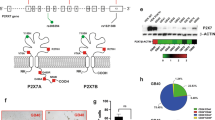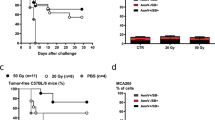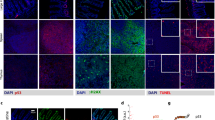Abstract
Neuroleptic drugs that bind sigma sites were tested for their ability to inhibit growth and radiosensitize MCF-7 human breast cancer cells. Inhibition of growth by ∼ 50% occurred in cells exposed to pimozide (0.6 μM), haloperidol (10 μM), and the sigma ligand DTG (1,3-di(2-tolyl)guanidine, 20 μM), but no growth inhibition occurred in cells exposed to clozapine, a neuroleptic drug lacking sigma binding activity, or dextromethorphan, a selective sigma 1 binding ligand. Pimozide (2.5 μM), but not haloperidol (3.6 μM), enhanced the sensitivity of MCF-7 cells to γ radiation in clonogenic survival assays. Pimozide significantly decreased MCF-7 clonogenic survival following a 5 or 8 Gy dose of γ radiation, and the dose of radiation required for 1% survival (survival enhancement ratio, SER) was decreased by a factor of 2. Exposure of normal WI-38 human embryonic lung cells to pimozide did not increase their sensitivity to γ radiation. Pimozide (2.5 μM) activated early apoptotic changes in MCF-7 cells that were detected by the uptake of Hoechst 33342 dye, and 10 μM pimozide activated a complete apoptotic pathway resulting in the death of > 90% of the cells within 24 hours. MCF-7 cells exposed to γ radiation alone (8 Gy) showed giant cell formation, mitotic arrest, and a limited degree of apoptosis and necrosis. Within 50 hours of treatment with a combination of radiation and pimozide, cell numbers were sharply reduced compared with cultures exposed to either radiation or pimozide alone. We conclude that pimozide augmented the sensitivity of MCF-7 cells to radiation-induced cell killing through a mechanism not shared by haloperidol, but suggest that concentration of pimozide in MCF-7 cells as a result of an enrichment of sigma 2 sites might target the radiosensitization.
Similar content being viewed by others
References
Moebius FF, Reiter RJ, Hanner M, Glossmann H: High affinity of sigmal-binding sites for sterol isomerization inhibitors: evidence for a pharmacological relationship with the yeast stcrol C8-C7 isomerase. Br J Phaimacol 121: 1–6, 1997
Moebius FF, Striessnig J, Glossmann H: The mysteries of sigma receptors: new family members reveal a role in cholesterol synthesis. Trends Pharmacol Sci 18: 67–70, 1997
Bowen WD, Tlentino PJ, Kirschner BN, Varghesc P, DeCosta BR, Rice KC: Sigma receptors and signal transduction: negative modulation of signaling through phosphoinositide-linked receptor systems. In: DeSouza EB, London ED, Clouet DH (eds) Sigma, PCP, and NMDA Receptor Systems, NIDA Monograph Series. Government Printing Office, Washington, D.C., 1990 pp 69–93
Joseph DB, Bowen WD: Investigation of sigma receptor-Gprotein interaction using stimulation of [S35]GTPγS binding to rat cerebellar and human SK-N-SH neuroblastoma cell membranes. Soc Neurosci Abstract 905. 8, 1997
Su T-P: Delineating biochemical and functional properties of sigma receptors: emerging concepts. Crit Revs Neurobiol 7: 187–203, 1993
Walker JM, Bowen WD, Walker FO, Matsumoto RR, De-Costa B, Rice KC: Sigma receptors: biology and function. Pharmacol Revs 42: 355–402, 1990
Morio Y, Tanimoto H, Yakushiji T, Morimoto Y: Characterization of the currents induced by sigma ligands in NCB20 neuroblastoma cells. Brain Res 637: 190–196, 1994
Nakazawa K, Ito K, Koizumi S, Ohno Y, Inouc K: Characterization of inhibition by haloperidol and chlorpromazine of a voltage-activated K + current in rat phaeochromocytoma cells. Br J Pharmacol 118: 2603–2610, 1995
Brent PJ, Herd L, Saunders H, Sim ATR, Dunkley PR: Protein phosphorylation and calcium uptake into rat forebrain synaptosomes: modulation by the sigma ligand, 1,3-ditolylguanidine J Neurochem 68: 2201–2211, 1997
Quirion R, Bowen WD, Itzhak Y, Junien JL, Musacchio JM, Rothman RB, Su T-S, Tam W, Taylor DP: A proposal for the classification of sigma binding sites. Trends Pharmacol Sci 13: 85–86. 1992
McCann DJ, Weissmann AD, Su T-P: Sigma-1 and sigma-2 sites in rat brain: comparison of regional, ontologenetic, and subcellular patterns. Synapse 17: 182–189, 1994
Debonnel G: Current hypotheses on sigma receptors and their physiological role: possible implications in psychiatry. J Psychiatr Neurosci 18: 157–172, 1993
Kerbusch T, Desta Z, Soukova NV, Thacker D, Flockhart A: Sensitive assay for pimozide in human plasma using high-performance liquid chromatography with fluorescence detection: application to pharmacokinctic studies. J Chromatog B 694: 163–168, 1997
Wolfe SA, Culp SG, DeSouza EB: Sigma-receptors in endocrinc organs: identification, characterization, and autoradiographic localization in rat pituitary, adrcnal, testis, and ovary. Endocrinol 124: 1160–1172, 1989
Wolfe SA, Ila BK, Whitlock BB, Saini P: Differential localization of three distinct binding sites for sigma receptor ligands in rat spleen. J Neuroimmunol 72: 45–58, 1997
Hellewell SB, Bruce A, Feinstein G, Orringer J, Williams W, Bowen WD: Rat liver and kidney contain high densities of signa-1 and signa-2 receptors: characterization by ligand binding and photoaffinity labeling. Eur J Pharmacol 268: 9–18, 1994
Thomas GE, Szucs M, Mamone JY, Bem WT, Rush MD, Johnson FE, Coscia CJ: Sigma and opioid receptors in human brain tumors. Life Sci 46: 1279–1286, 1990
Bem WT, Thomas GE, Mamone JY, Homan SM, Levy BK, Johnson FE, Coscia CJ: Overexpression of sigma receptors in nonneural human tumors. Cancer Res 51: 6558–6562, 1991
John CS, Bowen WD, Varma VM, McAfee JG, Moody TW: Sigma receptors are expressed in human non-small cell lung carcinoma. Life Sci 56: 2385–2392, 1995
John CS, Vilner BJ, Gulden ME, Efange SMN, Langason RB, Moody TW, Bowen WD: Synthesis and pharmacological charactcrization of 4-[125I]-N-(N-benzylpiperidin-4-yl)-4-iodobenzamide: a high affinity sigma receptor ligand for potential imaging of breast cancer. Cancer Res 55: 3022–3027, 1995
Vilner BJ, John CS, Bowen WD: Sigma-1 and sigma-2 receptors are expressed in a wide variety of human and rodent tumor cell lines. Cancer Res 55: 408–413, 1995
Vilner BJ, Bowen WD: Sigma receptor-active neuroleptics are eytotoxic to C6 glioma cells in culture. Eur J Pharmacol 244: 199–201, 1993
Strobl JS, Kirkwood KL, Lantz TK, Lewine MA, Peterson VA, Worley JW III: Inhibition of human breast cancer cell proliferation in tissue culture by the neuroleptic agents pimozide and thioridazine. Cancer Res 50: 5399–5405, 1990
Strobl JS, Peterson VA: Tamoxifen-resistant human breast cancer cell growth: inhibition by thioridazine, pimozide and the calmodulin antagonist, W-13. J Pharmacol Expt Ther 263: 186–193, 1992
Vilner BJ, DeCosta BR, Bowen WD: Cytotoxic effects of sigma ligands: sigma receptor-mediated alterations in cellular morphology and viability. J Neurosci 15: 117–134, 1995
Brent PI, Pang GT: Sigma binding site ligands inhibit cell proliferation in mammary and colon carcinoma cell lines and melanoma cells in culture. Eur J Pharmacol 278: 151–160, 1995
Brent PJ, Pang G, Little G, Dosen PJ, Van Helden DF: The sigma receptor ligand, reduced haloperidol, induces apoptosis and increases intracellular-free calcium levels in colon and mammary adenocarcinoma cells. Biochem Biophys Res Commun 219: 219–226, 1996
Tam SW, Cook L: Sigma opiates and certain antipsychotic drugs mutually inhibit (+)-[3H]SKF 10.047 and [3H]haloperidol binding in guinea pig brain membranes. Proc Natl Acad Sci USA 81: 5618–5621, 1984
Weber E, Sonders M, Quarum M, McLean S, Pou S, Keana JFW: 1,3-di(2-[5-3H]tolyl)guanidine: a selective ligand that labels sigma-type receptors for psychotomimetic opiates and antipsychotic drugs. Proc Natl Acad Sci USA 83: 8784–8788, 1986
Hanner M, Moebius FF, Flandorfer A, Knaus H-G, Striessnig J, Kempner E, Glossmann H: Purification, molecular cloning, and expression of the mammalian sigma-1 binding site. Proc Natl Acad Sci USA 93: 8072–8077, 1996
Mach RH, Smith CR, Al-Nabulsi I, Whirrett BR, Childers SR, Wheeler KT: Sigma 2 receptors as potential biomarkers of proliferation in breast cancer. Cancer Res 57: 156–161, 1997
Everaert H, Flamen P, Franken PR, Verhaeghe W, Bossuyt A: Sigma-receptor imaging by means of 1-125-IDAB scintigraphy: clinical application in melanoma and non-small cell lung cancer. Anticancer Res 17: 1577–1582, 1997
John CS, Lim BB, Geyer BC, Vilner BJ, Bowen WD: 99mTc-labeled sigma-receptor binding complex: synthesis, characterization, and specific binding to human ductal breast earcinoma (T47D) cells. Bioconjug Chem 8: 304–309, 1997
Waterhouse RN, Chapman J, Izard B, Donald A, Belbin K, O'Brien JC, Collier TZ: Examination of four 1251-labeled piperidine-based sigma receptor ligands as potential melanoma imaging agents: initial studies in mouse tumor models. Nue Med Biol 24: 587–593, 1997
Levenson AS, Jordan VC: MCF-7: the first hormone-responsive breast cancer cell line. Cancer Res 57: 3071–3078, 1997
Chen AY, Okunieff P, Pommier Y, Mitchell JB: Mammalian DNA topoisomerase I mediates the enhancement of radiation cytotoxicity by camptothecin derivatives. Cancer Res 57: 1529–1536, 1997
Eguchi Y, Shimiza, S, Tsujinioto Y. Intracellulat ATP levels determine cell fate by apoptosis or necrosis. Cancer Res 57: 1835–1840, 1997
Kenakin T: Molecular pharmacology: a short course. Blackwell Science, Cambridge, MA, 1997
Bergeron R, Dubonnel G: Effects of low and high doses of selective sigma ligands: further evidence suggesting the existence of different subtypes of sigma receptors. Psychopharmacol 129: 215–224, 1997
Pizer ES, Jackisch C, Wood FD, Pasternack GR, Davidson NF, Kuhajda FP: Inhibition of fatty acid synthesis induces programmed cell death in human breast cancer cells. Cancer Res 56: 2745–2747, 1996
Sokolova IA, Cowan KH, Schneider E: Ca-2/Mg+2-dependent endonuclease activation is an early event in VP-16 induced apoptosis of human breast cancer MCF-7 cells in vitro. Biochim Biophys Acta 1266: 135–142, 1995
Dewey WC, Ling CC, Meyn RE: Radiation-induced apoptosis: relevance to radiotherapy. Int J Radiation Oncol Biol Phys 33: 781–796, 1995
Levine AJ: p53, the cellular gatekeeper for growth and division. Cell 88: 323–331, 1997
McCormick B: Radiation therapy for breast cancer. Curr Opin Oncol 7: 511–516, 1995
Hannun YA: Functions of ceramide in coordinating cellular responses to stress. Science 274: 1855–1859, 1996
Jarvis WD, Grant S, Kolesnick RN: Ceramide and the induction of apoptosis. Clin Cancer Res 2: 1–6, 1996
Karin M, Lin Z-G, Zandi E: AP-1 function and regulation. Curr Opin Cell Biol 9: 240–246, 1997
Hermeking H, Eick D: Mediation of c-myc-induced apoptosis by p53. Science 265: 2091–2093, 1994
Decaudin D, Geley S, Hirsch T, Castedo M, Marchetti P, Macho A, Kofler R, Kroemer G: Bel-2 and Bel-XL antagonize the mitochondrial dysfunction preceding nuclear apoptosis induced by chemotherapeutic agents. Cancer Res 57: 62–67, 1997
Yu K, Ravera CP, Chen Y-NP, McMahon G: Regulation of myc-dependent apoptosis by p53, c-jun N-terminal kinases/stress-activated protein kinases, and mdm-2. Cell Growth Diff 8: 731–742, 1997
Turner BC, Haffty BG, Narayanan L, Yuan I, Havre PA, Gumbs AA, Kaplan L, Burgard J-C, Carter D, Baserga R, Glazer PM: Insulin-like growth factor-1 receptor overexpression mediates cellular radioresistance and local breast cancer recurrence after lumpectomy and radiation. Cancer Res 57: 3079–3083, 1997
Dalta SR: Akt phosphorylation of BAD couples survival signals to the cell intrinsic death machinery. Cell 91: 231–241, 1997
Cuvillier O, Pirianov G, Kleuser B, Vanek PG, Coso OA, Gutkind JS, Spiegel S: Suppression of ceramide-mediated programmed cell death by sphingosine-1-phosphate. Nature 381: 800–803, 1996
Jarvis WD, Auer KL, Spector M, Kunos G, Grant S, Hylemon P, Mikkelsen R, Dent P. Positive and negative regulation of JNK1 by protein kinase and p42 MAP kinase in adult rat hepatocytes. FEBS Letts 412: 9–14, 1997
Chmura SJ, Nodzenski E, Beckett MA, Kufe DW, Quintans J, Weichselbaum RR: Loss of ceramide production confers resistance to radiation-induced apoptosis. Cancer Res 57: 1270–1275, 1997
Verheij M, Bose R, Lin X, Yao B, Jarvis B, Grant S, Birere M, Szabo E, Zon L, Kryriakis J, Haimovitz-Friedman A, Fuks Z, Kolesnick R: Requirement for ceramide-initiated SAPK/JNK signaling in stress-induced apoptosis. Nature 380: 75–79, 1996
Nakamura K, Antoku S: Enhancement of X-ray cell killing in cultured mammalian cells by the protein phosphatase inhibitor calyculin A. Cancer Res 54: 2088–2090, 1994
Levin RM, Weiss B: Mechanism by which psychotropic drugs inhibit adenosine cyclic 3′,5′-monophosphate phosphodiesterase of brain. Mol Pharmacol 12: 581–589, 1976
Weiss B, Prozialeck WC, Wallace TL: Interaction of drugs with calmodulin: biochemical, pharmacological and clinical implications. Biochem Pharmacol 31: 2217–2226, 1982
Shenoy MA, Singh BB: Chemical radiosensitizers in cancer therapy. Cancer Invest 10: 533–551, 1992
Withins HR: Biology of radiation oncology. In: Tobias JS, Thomas PRM (eds) Current Radiation Oncology. Edward Arnold, Great Britain, 1994, pp 5–23
Author information
Authors and Affiliations
Rights and permissions
About this article
Cite this article
Strobl, J.S., Melkoumian, Z., Peterson, V.A. et al. The cell death response to γ-radiation in MCF-7 cells is enhanced by a neuroleptic drug, pimozide. Breast Cancer Res Treat 51, 83–95 (1998). https://doi.org/10.1023/A:1006046604062
Issue Date:
DOI: https://doi.org/10.1023/A:1006046604062




